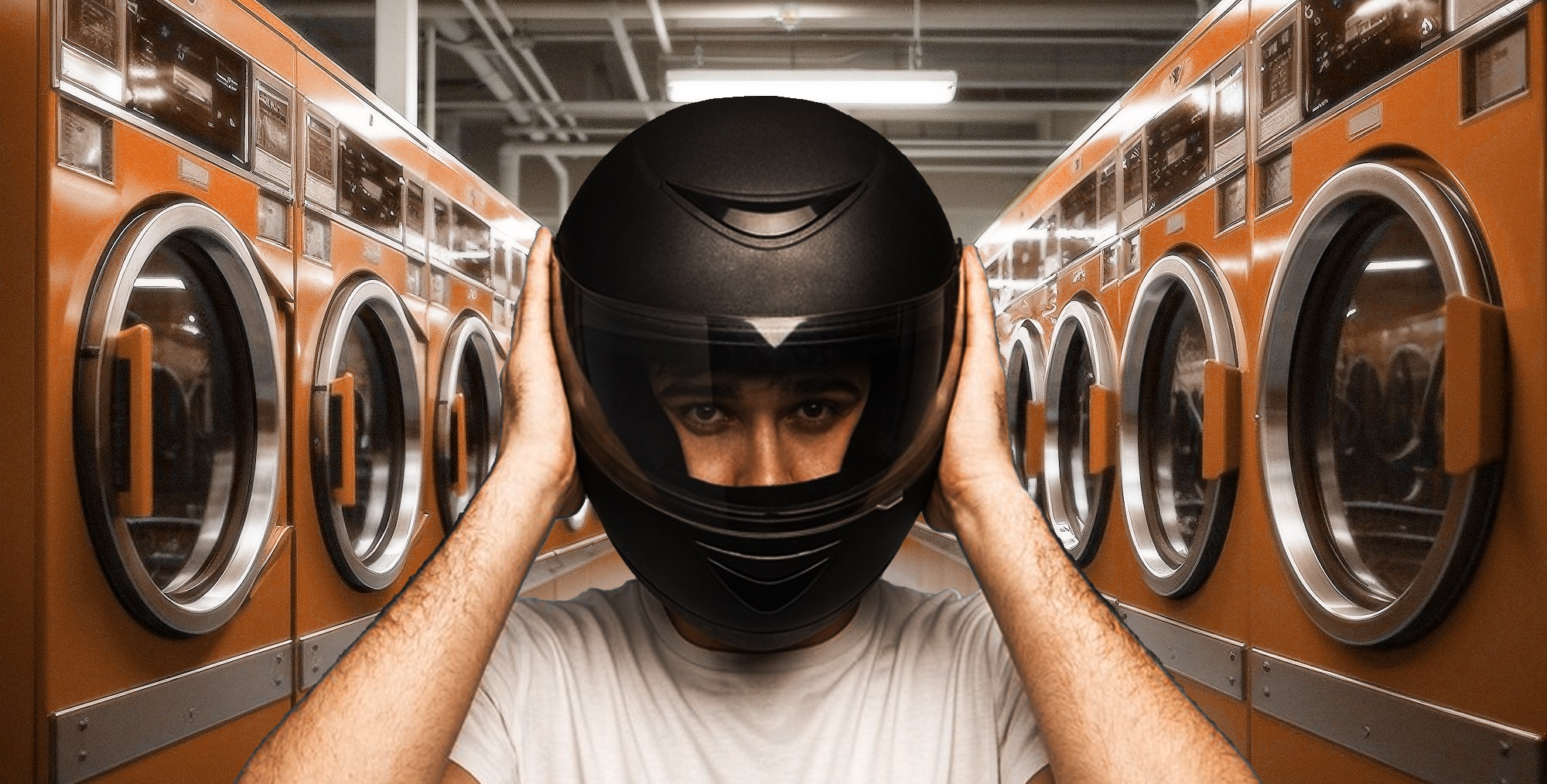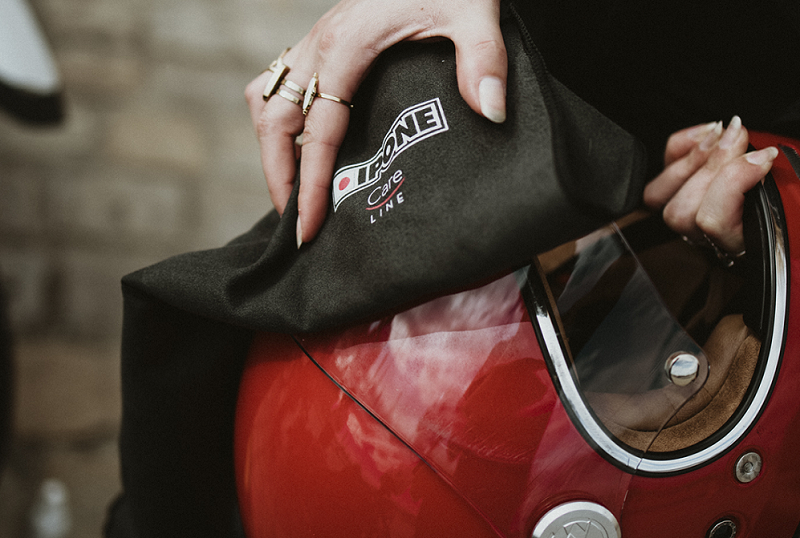
#equipment maintenance
Riding a motorcycle in summer means sweating through your gear. Jacket, helmet, boots: all your gear is going to give you a delicate whiff of sportsman's armpit juice. Don't you just love the smell of the locker room at the end of a match on your road trips? Then read our advice on how to look after your biker's gear - leather, textile, Goretex, etc. We'll give you all the tips you need to improve the life, efficiency and fragrance of your gear.
How do I wash my textile motorcycle jacket and pants?
Let's start with the easy part: taking care of your textile equipment. Why is this the easiest? They're machine-safe. Here are the best practices:![]()
Light cleaning of my textile motorcycle gear
If you opt for light cleaning (for example, to get rid of the outer layer of dried mosquitoes), all you need is a microfiber wipe or sponge. Soak it in lukewarm water and gently rub away the dirt.![]()
Opting for the big pre-wintering wash? Here's how it works
Start by removing the protectors (back, elbow, knee reinforcements, etc....). Next, detach the liners (thermal or waterproof) and wash them separately. Finally, before putting your jacket or pants in the machine, remember to close the zips and press studs to avoid putting too much strain on the openings. What washing program should I choose? Delicate at 30°C maximum. Above all, avoid fabric softeners or other products containing bleach or solvents.![]()
Drying
Once you've washed your biker gear, you'll need to be patient. Tumble-dryers, hairdryers and radiators are absolutely out of the question. The best option is to lay your gear out on a hanger in a well-ventilated room and wait, dreaming of your next road-trip.![]()
How do I wash my motorcycle jeans?
Same instructions as for textiles! That way, it's easy. With the same logic, and if possible, remove the knee and hip reinforcements. Then machine wash on a delicate 30°C program. The best part? Wash inside out. This will greatly reduce fading caused by machine washing.
How do I clean my Goretex motorcycle gear?
What is Goretex? If you're interested, we've devoted an entire article to this material. But to put it simply: it's a fabric with a mesh fine enough to prevent water from passing through, but wide enough to let air circulate. So it's both waterproof and breathable. So no magical unicorn powder is applied to it.
Which means you can machine-wash it at 40°C on a delicate program without fear of altering its effectiveness. The recommendations are to rinse twice in moderate spin mode, and to avoid using washing powder, fabric softener, stain remover or bleach. You should also know that a little regular maintenance goes a long way. Simply wipe the outer surface of your Gore-Tex pants or jacket with a cloth, sponge or micro-fiber wipe (soaked in lukewarm water). This will remove any surface dirt.
The good news? GoreTex can be tumble-dried on a delicate program at moderate temperature (except for those with constant water repellency). In fact, 20 minutes in the dryer even revives its water-repellent properties! On the other hand, if you notice that the water no longer beads or slides off the surface of the garment, it's time to reapply a water-repellent product (DWR).
----> Motorex Protex textile and leather waterproofing 500ml

How to care for your leather motorcycle gear
Whether it's your jacket, pants or gloves, there are two steps: wash and nourish. Yes, it's a living material. So it needs to eat and breathe. But over the miles, dirt and insects of all kinds will "asphyxiate" it, while wind and sun will dry it out and harden it, melting its natural fat.
![]()
Cleaning your leather motorcycle outfit
Solvents, abrasive materials and leather's nemesis, the washing machine, should be avoided at all costs. In fact, the best thing to do is to rough up the wash with a soft bristle brush to remove the collection of tartar mosquitoes , then complete the cleaning with a soft, damp cloth. Of course, if your leather garment has linings, you can machine-wash them separately, following the same instructions as for textiles.
![]()
Nourishing the leather of my biker gear
It's imperative to opt for a cleaning product dedicated to leather. Apply it to a soft cloth, then stroke your jacket in circles with your hand. This almost carnal massage will let your leather jacket know that you care about it and its health. What's next? Continue these delicate gestures to remove excess nourishing balm. For the finishing touch (by hand, of course), you can opt for a final coat of a special leather waterproofing product. Your jacket or pants are as good as new.
How to wash and care for motorcycle gloves?
Nothing could be simpler. For textile, Gore-tex or leather models, you can refer to the previous paragraphs.In fact, the only special feature when it comes to washing gloves concerns the rigid outer shells, particularly those around the knuckles. These can be wiped clean with a damp cloth. There's no need to take any special precautions for these simple plastic moldings. Finally, although it may be tempting to dry your gloves on a radiator, avoid doing so. Always opt for natural drying in a well-ventilated room.
How to clean motorcycle boots
What's so special about motorcycle boots? Well, they're not machine-washable - no surprise there. So you'll have to wash the outside and inside by hand.
![]()
Washing and caring for the outer surface of motorcycle boots
For motocross or enduro models, there's no need to fuss: a blast of water or even a Karcher will do the trick. And yes, it's mostly plastic, so you might as well save time. The point of vigilance? Cloth shutters over openings.
For Gore-tex adventurer's boots, use the same technique as for jackets and pants. Which means? Clean the outside with a damp cloth, sponge or soft bristle brush. This will free the mesh from dirt that prevents it from breathing.
What about leather? Same process as for jackets, pants and gloves. First, clean the leather with a cloth or soft bristle brush to remove impurities. Then nourish the surface with a cleansing balm. What to look out for Choose the right product for your type of leather. Full grain, Nubuk, waxed, Suede: each material has its own nourishing treatment. Can you imagine feeding your dog hay? Or Frolix dry food for your dwarf goat? A coat of waterproofing comple tes the rejuvenation of your podal epidermis. What about baby milk, kerosene or candle wax? These are just penny-wise and pound-foolish. Let's be clear: forget those old-fashioned remedies that are supposed to nourish the leather of your equipment. When you spend €200 or €300 on a pair of boots, you might as well spend €20 or €30 on dedicated products that will really extend the life of your equipment, right?
![]()
Washing and caring for the inside of your motorcycle boots
The outside is all well and good, but don't forget the inside of your boots. That's where you put your foot. How do you take care of it? The first thing to do is to take out the sole. Imbibed with a delicate cocktail of sweat and sock juice, it needs a hand or machine wash. Then (and even if your toes aren't sensitive to odors) you need to disinfect and deodorize the inner foams. For this, there are dedicated sanitizing products that are super-efficient. In addition to preventing gastric reflux each time you take off your shoes, this will destroy the bacteria present in your boot.
----> Helmet Care Motorex (suitable for boot and helmet interior foams)
How do I wash my motorcycle helmet?
Taking care of your helmet takes time. So much so that we've already written an article dedicated to the subject. The crucial point to remember? Doing things right means dismantling, cleaning and reassembling. It takes time, but it guarantees optimum results.
![]()

What are the best ways to store motorcycle equipment?
Winter's approaching and you're not tempted to ride at -5°C? Here are a few recommendations for storing your motorcycle equipment:
Helmet, gloves, jacket and pants should be stored in a dry, well-ventilated place! This prevents the development of mold. What's more, make sure you store them in the right position so that the protectors don't warp.
Jackets can be stored on wooden hangers, leaving the various reinforcements in place. Why a wooden hanger? More rigid than a plastic model, it won't bend under the weight of your jacket. The same goes for pants, but after removing the protective shells. Gloves should be laid flat. The mistake to avoid? Leaving them in the helmet. As well as distorting them, they'll prevent the foams in your favorite headgear from breathing.
What's the best way to store your boots? Don't leave your socks in them. Otherwise, after a few weeks, a whole microcosm will have developed... And if you're really a purist, it's advisable to keep your boots closed so they don't warp.
What about your helmet? Not much to say. The best thing is to keep it in its helmet cover (often sold with it). This allows it to breathe without collecting dust. And ideally (but here we're getting into the nitty-gritty) you can leave the visor slightly ajar to allow a trickle of air to pass through.
That's all there is to it! Keep in mind that regular maintenance prolongs the life of your equipment! So, if you're going to invest in quality equipment, you might as well look after it.
If you'd like to learn more, here's our Youtube video :
.
.
.
Our last posts
#interviewmotarde #etonvaoumaintenant #motardevoyageuse #voyagemoto
#hivernale #millevaches #équipementmotard #aventuresmichel
#aventuresmichel #hardefitour #raidenduro #tout-terrain
Aucun produit
